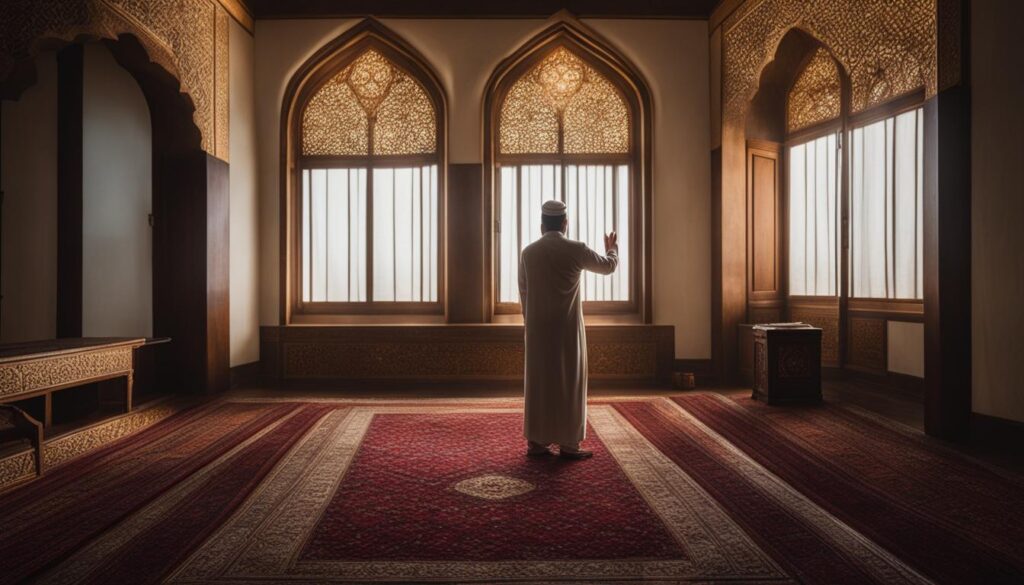Welcome to our easy guide on how to pray Fajr, the first prayer of the day for Muslims. In this comprehensive guide, we will walk you through the steps involved in performing Fajr prayer, including the correct body positions and recitations. Whether you are a beginner or just looking to refresh your knowledge, this guide will help you navigate the Fajr prayer with confidence.
But first, let’s understand the significance of Fajr prayer and why it holds great importance in Islam. Fajr prayer marks the beginning of a Muslim’s daily worship and sets the tone for a successful and blessed day ahead. By dedicating yourself to perform Fajr prayer, you show your commitment and dedication to your faith.
Before we delve into the details of performing Fajr prayer, it is important to prepare yourself for this sacred act of worship. Ensuring that you are in a state of ritual purity (wudu) and facing the direction of the Kaaba in Mecca are essential prerequisites. Additionally, establishing a sutrah, an object placed in front of you as a barrier, is recommended to maintain focus during the prayer.
To begin the Fajr prayer, raise your hands to shoulder level or the level of your ears while saying “Allahu Akbar” (Allah is Great). Make the intention for the Fajr prayer in your mind, and then recite Surah Fatiha and an additional Surah. Throughout the prayer, you will transition through various body positions, such as standing, bowing (ruku), prostration (sujood), and sitting.
It is important to remember the specific recitations and body positions during the prayer. During the bowing position (ruku), say “Subhana rab-bi yal adheem” (Glory be to my Lord who is the very greatest) three times. Likewise, during the prostration position (sujood), say “Subhana rubbiyal a’ala” (How perfect is my Lord, the Most High) three times. These recitations should be performed with proper form and concentration.
After completing the first rak’ah (unit) of the Fajr prayer, stand up for the second rak’ah and repeat the same body positions and recitations. Once the second sujood is completed, assume the sitting position for a short time before concluding the prayer.
To conclude the Fajr prayer, turn your face to the right and say “Assalamu alaikum wa rahmatullah” (Peace and mercy of Allah be upon you), and then turn your face to the left and repeat the same greeting. This marks the end of the Fajr prayer.
Now that you have a basic understanding of how to perform Fajr prayer, let’s explore some tips to help you pray Fajr consistently and establish it as a regular habit. By setting an alarm, seeking accountability, and prioritizing sleep and bedtime routines, you can ensure that you wake up on time for Fajr prayer.
So, let’s begin our journey towards a fulfilling Fajr prayer practice. Remember to seek knowledge, strive for consistency, and embrace the spiritual rewards that Fajr prayer brings.
Key Takeaways:
- Performing Fajr prayer signifies the beginning of a Muslim’s daily worship and sets the tone for a successful day ahead.
- Ensure that you are in a state of ritual purity and facing the direction of the Kaaba in Mecca before performing Fajr prayer.
- Establish a sutrah, an object placed in front of you, to create a barrier and maintain focus during the prayer.
- Recite specific phrases during the bowing (ruku) and prostration (sujood) positions with proper form and concentration.
- Conclude the Fajr prayer by turning your face to the right and left, greeting with “Assalamu alaikum wa rahmatullah.”
Importance of Fajr Prayer
The Fajr prayer holds immense significance in Islam, serving as the foundation of a Muslim’s daily worship. It is the first prayer of the day, marking the beginning of a new day devoted to the remembrance and obedience of Allah. By performing the Fajr prayer, Muslims demonstrate their dedication and commitment to their faith.
Praying Fajr has numerous benefits for both the spiritual and physical well-being of individuals. It brings immense blessings and rewards as mentioned in the Hadith, where the Prophet Muhammad (peace be upon him) said, “Whoever performs the Fajr prayer in congregation, then he is under Allah’s protection. So, beware, O son of Adam, that Allah does not call you to account for being absent from His protection for any reason.”
The significance of the Fajr prayer is also reflected in its timing. It is performed before sunrise when the world is still and quiet, providing a peaceful and serene environment for worship. This early morning prayer sets the tone for the rest of the day, bringing a sense of tranquility, gratitude, and focus to the hearts of the believers. It allows individuals to start their day in the best possible way, seeking Allah’s guidance and blessings for the challenges and tasks that lie ahead.

Performing the Fajr prayer consistently establishes a strong connection with Allah and strengthens the spiritual bond between the worshipper and their Creator. It is a reminder of the ultimate purpose of life and the importance of prioritizing one’s relationship with Allah. By fulfilling this obligatory act of worship, Muslims demonstrate their submission and devotion to Allah, seeking His mercy and guidance throughout their day.
Preparation for Fajr Prayer
Before performing the Fajr prayer, it is important to make the necessary preparations to ensure a focused and meaningful worship experience. One of the first steps is to ensure that you are in a state of ritual purity, known as wudu. Wudu involves washing the hands, mouth, nose, face, arms, head, and feet in a specific order, as prescribed by Islamic teachings. It is important to perform wudu with sincerity and mindfulness, as it purifies both the body and the soul.
In addition to being in a state of ritual purity, it is essential to face the direction of the Kaaba in Mecca, which is the holiest site in Islam. This direction, known as the qibla, is the focal point for Muslims during prayer. To determine the qibla, you can use a compass or rely on online resources that provide accurate qibla directions based on your location. Ensuring that you are facing the qibla helps create a sense of unity and connection with the Muslim community worldwide.
For women who are menstruating or experiencing post-childbirth bleeding, it is important to note that they are exempt from performing prayers during this time. It is recommended to wait until purification is complete before resuming prayers. This period of exemption allows women to focus on their physical and emotional well-being without the pressure of fulfilling prayer obligations.
| Preparation for Fajr Prayer | Benefits |
|---|---|
| Performing wudu | Purifies the body and soul |
| Facing the qibla | Creates a sense of unity and connection |
| Exemption for women during menstruation | Allows focus on physical and emotional well-being |
Another aspect of preparation for Fajr prayer is establishing a sutrah. A sutrah is an object placed in front of the praying person to create a barrier. It can be as simple as a chair or a small object. Having a sutrah helps maintain focus and prevents distractions during the prayer. By establishing a sutrah, you are creating a physical reminder of the sacred space for prayer.
Taking the time to prepare for Fajr prayer not only ensures that you are in the right state of mind and body for worship but also helps create a sense of reverence and connection with the divine. The preparation process allows you to enter the prayer with a clear and focused mindset, enabling you to fully engage in the spiritual experience.
Starting the Fajr Prayer
Starting the Fajr prayer correctly is essential for a fulfilling spiritual experience. This section will guide you through the initial steps of beginning the Fajr prayer, from the opening takbir to the recitation of Surah Fatiha.
- Begin by standing upright and raising both hands to shoulder level or the level of the ears, while saying the takbir, “Allahu Akbar” (Allah is Great). This marks the start of the prayer.
- Next, make the intention for the Fajr prayer in your mind. Intentions for prayers are internal and do not require vocalization.
- After the intention, recite Surah Fatiha, the opening chapter of the Quran, followed by an additional Surah of your choice. This recitation is only performed in the first rak’ah (unit) of the Fajr prayer.
By reciting Surah Fatiha and an additional Surah, you establish a connection with Allah and seek His guidance and blessings for the day ahead. It is important to recite the verses with proper pronunciation and understanding, as it deepens your spiritual engagement during the prayer.
“Reciting the Quran during the Fajr prayer is a highly virtuous act. It purifies the heart and brings tranquility to the soul.”
After completing the recitation, you will progress through various body positions as part of the Fajr prayer, including standing, bowing, prostrating, and sitting. These positions and their significance will be explored in the following sections.

| Steps | Description |
|---|---|
| Raising Hands | Raise both hands to shoulder level or the level of the ears, saying “Allahu Akbar” (Allah is Great). |
| Intention | Make the intention for the Fajr prayer in your mind. |
| Recitation | Recite Surah Fatiha, followed by an additional Surah in the first rak’ah (unit) of the Fajr prayer. |
Rukn and Sujood in Fajr Prayer
One of the essential aspects of performing the Fajr prayer correctly is understanding the body positions involved, specifically the rukn (bowing position) and sujood (prostration position). These positions hold significant importance, as they demonstrate humility and submission to Allah during the prayer.
During the rukn, the individual should bend forward from the standing position, placing their hands on their knees and keeping their back straight. While in this position, it is customary to recite the phrase “Subhana rab-bi yal adheem” (Glory be to my Lord who is the very greatest) three times, emphasizing the reverence and praise for Allah.
Next, the individual transitions into the sujood position, where they place their forehead, nose, palms, knees, and toes on the ground. This position symbolizes complete surrender and devotion to Allah. While in sujood, it is recommended to recite the phrase “Subhana rubbiyal a’ala” (How perfect is my Lord, the Most High) three times, further emphasizing the glorification of Allah.
“Glory be to my Lord who is the very greatest.”
By performing the rukn and sujood with proper form and concentration, the individual engages in a profound spiritual experience, connecting with their Creator and reinforcing their commitment to the Fajr prayer.
| Body Position | Recitation |
|---|---|
| Rukn (Bowing) | “Subhana rab-bi yal adheem” (Glory be to my Lord who is the very greatest) |
| Sujood (Prostration) | “Subhana rubbiyal a’ala” (How perfect is my Lord, the Most High) |
Second Rakah of Fajr Prayer
After completing the first rak’ah of the Fajr prayer, it is time to proceed to the second rak’ah. In this rak’ah, the steps and recitations are repeated, ensuring that the proper form and concentration are maintained. Here is a step-by-step guide to performing the second rak’ah of Fajr prayer:
- Stand up from the sitting position after completing the first rak’ah.
- Raise both hands to shoulder level or the level of the ears while saying “Allahu Akbar” (Allah is Great).
- Make the intention for the second rak’ah in your mind.
- Recite Surah Fatiha, the opening chapter of the Quran, followed by an additional Surah of your choice.
- Perform the bowing position, known as “ruku,” while saying “Subhana rab-bi yal adheem” (Glory be to my Lord who is the very greatest) three times.
- Move into the prostration position, known as “sujood,” while saying “Subhana rubbiyal a’ala” (How perfect is my Lord, the Most High) three times.
- Repeat the recitations and body positions in the same manner as the first rak’ah.
- After completing the second sujood, assume the sitting position for a short time before concluding the prayer.
Performing the second rak’ah of Fajr prayer is an integral part of completing the obligatory prayer. It is important to follow the proper sequence of recitations and body positions to ensure that the prayer is performed correctly and in accordance with the teachings of Islam.
| Position | Recitation/Action |
|---|---|
| Standing | Raise hands to shoulder level and say “Allahu Akbar” (Allah is Great). |
| Intention | Make the intention for the second rak’ah in your mind. |
| Recitation | Recite Surah Fatiha and an additional Surah. |
| Bowing (Ruku) | Say “Subhana rab-bi yal adheem” (Glory be to my Lord who is the very greatest) three times. |
| Prostration (Sujood) | Say “Subhana rubbiyal a’ala” (How perfect is my Lord, the Most High) three times. |
| Repetition | Repeat recitations and body positions as in the first rak’ah. |
| Conclusion | Assume the sitting position for a short time before ending the prayer. |
By following these steps, beginners can perform the second rak’ah of Fajr prayer with ease and confidence. It is crucial to remember that consistent practice and dedication are key to developing a strong prayer routine.

Conclusion of Fajr Prayer
Concluding the Fajr prayer is a moment of peace and reflection, as it marks the end of the first prayer of the day. After completing the final sujood (prostration), it is important to complete the prayer with the proper etiquette. This includes turning the face to the right and saying “Assalamu alaikum wa rahmatullah” (Peace and mercy of Allah be upon you), and then turning the face to the left and repeating the same greeting. This signifies the end of the Fajr prayer and the beginning of a new day filled with blessings and opportunities.
By properly concluding the Fajr prayer, it helps to reinforce the importance of maintaining a consistent prayer routine and strengthens the connection with Allah. It is a moment to express gratitude for the ability to worship and seek guidance for the day ahead. The conclusion of Fajr prayer sets a positive tone for the rest of the day and reminds us of the importance of faith in our daily lives.
Remember, the Fajr prayer is not just a physical act of worship, but a spiritual connection with the divine. By performing it with sincerity and reverence, we can experience the true essence of this beautiful prayer and receive the rewards and blessings associated with it. May we all strive to make Fajr prayer a regular part of our lives and continue to deepen our relationship with Allah through this sacred act of worship.
Table: Steps to Conclude Fajr Prayer
| Step | Description |
|---|---|
| 1 | Complete the final sujood (prostration) |
| 2 | Turn the face to the right |
| 3 | Say “Assalamu alaikum wa rahmatullah” (Peace and mercy of Allah be upon you) |
| 4 | Turn the face to the left |
| 5 | Repeat the same greeting |
Tips for Praying Fajr Consistently
Praying Fajr consistently is a crucial aspect of a Muslim’s daily worship routine. Here are some practical tips to help you make Fajr prayer a habit:
- Set an alarm: Be proactive in waking up for Fajr prayer by setting an alarm that is loud enough to ensure you don’t sleep through it. Place your alarm away from your bed to avoid hitting the snooze button.
- Seek accountability: Find a Muslim friend or family member who shares your goal of praying Fajr consistently. Hold each other accountable by checking in regularly and encouraging one another to stay committed to this important act of worship.
- Prioritize sleep: Establish a consistent sleep schedule and make sure to get enough rest each night. Avoid staying up late unnecessarily and create a bedtime routine that helps you wind down and prepare for an early wake-up.
- Seek knowledge: Educate yourself about the importance and rewards of Fajr prayer. Watch instructional videos or read guides that explain the proper way to perform Fajr prayer. This knowledge will enhance your understanding and motivation.
“Praying Fajr consistently is not just about waking up early; it is about prioritizing your relationship with Allah and seeking His blessings throughout the day.”
Remember, making Fajr prayer a habit requires discipline and perseverance. It may take time to adjust to the new routine, but the spiritual benefits and rewards are truly worth it. Stay committed, seek Allah’s guidance, and experience the peace and blessings that come with the consistent practice of Fajr prayer.
Tips for Praying Fajr Consistently:
| Tips | Description |
|---|---|
| Set an alarm | Set a loud alarm away from your bed to wake you up for Fajr prayer. |
| Seek accountability | Find a Muslim friend or family member to hold you accountable for praying Fajr regularly. |
| Prioritize sleep | Establish a consistent sleep schedule and create a bedtime routine to ensure you get enough rest. |
| Seek knowledge | Learn about the importance of Fajr prayer and how to perform it correctly by watching instructional videos or reading guides. |
Praying Fajr consistently is not just about waking up early; it is about prioritizing your relationship with Allah and seeking His blessings throughout the day. With dedication and perseverance, you can make Fajr prayer a habit that brings immense spiritual benefits and fulfillment to your life.
Importance of Memorizing Surah Fatiha
Memorizing Surah Fatiha holds immense significance in the Fajr prayer. Surah Fatiha is the opening chapter of the Quran and is recited in every unit of the Fajr prayer. By committing this beautiful prayer to memory, Muslims can deepen their connection with Allah and enhance their prayer experience.
Surah Fatiha is a powerful supplication to Allah, encompassing praise, gratitude, and plea for guidance. It sets the tone for the entire Fajr prayer and acts as a reminder of the importance of seeking Allah’s guidance in every aspect of life.
Memorizing Surah Fatiha not only allows for a smoother and more focused prayer, but it also facilitates a deeper understanding of the words being recited. This chapter holds deep meaning and serves as a source of spiritual reflection and contemplation.
By devoting time to memorize Surah Fatiha, individuals can strengthen their relationship with the Quran and improve their overall understanding of Islamic teachings. It is a practice that brings immense blessings and enables believers to connect with the divine message of Allah in a profound way.
FAQ
What is the importance of Fajr prayer?
Fajr prayer holds great importance in Islam as it is the first prayer of the day and signifies the beginning of a Muslim’s daily worship. It shows dedication and commitment to the faith, and the rewards for praying Fajr are multiplied.
How should I prepare for Fajr prayer?
Before performing Fajr prayer, ensure that you are in a state of ritual purity (wudu) and facing the direction of the Kaaba in Mecca. Women who are menstruating or experiencing post-childbirth bleeding should refrain from praying until their purification is complete.
What are the steps to start the Fajr prayer?
To begin the Fajr prayer, raise both hands to shoulder level or the level of the ears while saying “Allahu Akbar” (Allah is Great). Make the intention for Fajr prayer in your mind and recite Surah Fatiha and an additional Surah. Follow the proper body positions and recitations.
What are the rukn and sujood in Fajr prayer?
The Fajr prayer includes two rukn (bowing positions) and two sujood (prostration positions). During rukn, say “Subhana rab-bi yal adheem” (Glory be to my Lord who is the very greatest) three times, and during sujood, say “Subhana rubbiyal a’ala” (How perfect is my Lord, the Most High) three times.
How do I perform the second rak’ah of Fajr prayer?
After completing the first rak’ah, stand up for the second rak’ah and repeat the same body positions and recitations as in the first rak’ah. Recite Surah Fatiha and an additional Surah in the second rak’ah. Once the second sujood is completed, assume the sitting position for a short time before concluding the prayer.
How do I conclude the Fajr prayer?
To conclude the Fajr prayer, turn the face to the right and say “Assalamu alaikum wa rahmatullah” (Peace and mercy of Allah be upon you), then turn the face to the left and repeat the same greeting. This marks the end of the Fajr prayer.
What are some tips for praying Fajr consistently?
Some tips for establishing a regular Fajr prayer routine include setting an alarm, seeking accountability from a Muslim friend or imam, and prioritizing sleep and bedtime routines to ensure waking up on time. Watching instructional videos or reading guides on the proper way to perform Fajr prayer can also be helpful.
Why is it important to memorize Surah Fatiha?
Memorizing Surah Fatiha is highly recommended as it is the opening chapter of the Quran and is recited in every unit of the Fajr prayer. It is a beautiful and powerful prayer that reflects praise and supplication to Allah, enhancing the prayer experience and deepening the connection with Allah.








